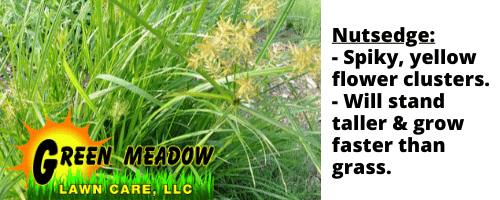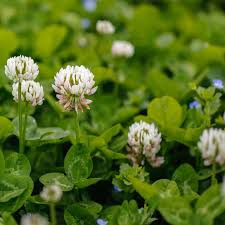Getting Rid of Weeds In My Yard
We have all been there - you have a lawn full of pesky weeds. What do you do? We are here to help offer some tips on how to better identify and manage weeds on your property.
Some weeds can be more aggressive than others. Some are just eye sores, while others cause harm by robbing water and nutrients from other plants. Below we'll cover both weed identification and weed treatment.
Weed: /noun/ A wild plant growing where it is unwanted and in competition with cultivated plants.
How Do I Identify Dandelions?
Dandelion leaves have a rigged, tooth-like edge. They are a perennial and can grow as high as 25-30 centimeters tall. They are the most common broadleaf weed in lawns.
Beginning as a yellow flower and growing into a white puffy top, dandelions reproduce by having their seedlings being carried in the wind. Each dandelion flower produces up to 200 seeds.
How to control Dandelions:
The most efficient way to control dandelions is to spray with a broadleaf herbicide. This will kill the entire plant, rather than just the leaves, without harming the surrounding healthy grass.
How Do I Identify Crabgrass?
Crabgrass can be identified by the “clumps” it grows in. Its blades tend to grow outward rather than inward (much like the legs of a crab). Crabgrass is an opportunistic weed and will grow in thin and bare spots of your lawn.
You will commonly find it growing in the cracks of driveways and sidewalks. It’s important to maintain a healthy lawn because crabgrass will eventually spread and take over a thin lawn.
- When Should I Treat For Crabgrass?
- How To Prevent/Control Crabgrass
- Pre Emergent vs Post Emergent Weed Control
How To Control Crabgrass:
Crabgrass can be controlled with both pre and post emergent herbicides but we find pre emergents applied in the spring to be the most successful.
How Do I Identify Nutsedge?
Nutsedge is a perennial weed that can be confused for grass but grows faster than typical turf grass. Nutsedge spreads via an underground system of tubers, making it very hard to completely get rid of it. Nutsedge can be identified by its triangular stem and can produce ether yellow or purple small flowers.

Nutsedge Control:
Nutsedge is not a broadleaf weed so your typical broadleaf weed herbicide will have little to no effect on nutsedge. Effective nutsedge treatment requires specialty products that can oftentimes be much more costly.
How Do I Identify White Clover?
White clover is a perennial that is commonly found in yards and meadows. It can handle heavy foot traffic and stands around 6 inches tall. It has heart-shaped leaves and produces white flowers.

How Do I Identify Poa Annua or Annual Blue Grass?
Poa annua is a common annual weed found in lawns each Spring. It is an undesirable grass because it dies off quickly in the season, leaving bare patches in your yard. You might recognize it by it's seed heads and lighter green color.
.png?width=306&name=Poa%20Annua%20(1).png)
How Do I Get Rid of Poa Annua In My Lawn?
The best way to treat Poa Annua or Annual Bluegrass is to use a pre emergent in late Spring or early Fall. Fall is when this grass does most of its germinating so this forms a barrier in the soil, preventing seedlings from breaking through.
What are safe ways to get rid of weeds?
-
By Hand: The good old-fashioned hand removal method works fine but can be tedious. Be careful to not spread seeds while handling weeds and use a tool such as a claw or a sharp trowel to help you get the weed at its roots.
-
Mulching: When it comes to gardens and flower beds, this layer of organic material will smother weeds, preventing them from growing and spreading.
- Weed torch: This process involves burning weeds by passing over them with a hand held flame. Flaming weeding will only kill the plants above-ground. It will not kill the weed’s roots.
What’s a Good Home DIY Remedy for Weeds?
Believe it or not, there are a lot of at-home products that are most likely just laying around your house that could work for weed treatment! Some of these methods might take a bit of persistence but if you decide you’re up for the task they could be worth a try. Be aware that many of these methods work best for spot treatments.
-
Boiling Water: Similar to flaming weeds with a torch, the heat of boiling water will effectively kill your desired weeds.
-
Vinegar: Acetic acid in vinegar works to effectively kill weeds by burning the top of the plant where it is applied.
-
Newspaper: Similar to mulching, newspaper provides a barrier between sunlight and weed seeds, preventing them from sprouting.
How Do I Get Rid of Weeds in Flower Beds?
The 3 best ways to get rid of weeds in flower beds is by removing them by hand (at the root), laying about 6 inches of mulch to create a barrier between roots and sunlight, and/or spot-treating with a herbicide.
Pro Tip: If this is something that you find you don't have the time to do, talk to a lawn care professional about Bed Weed Control.
How Do I Get Rid of Moss in My Yard?
Moss is opportunist and can compete against grass for growing room in your yard. Keeping moss at bay will result in a healthier turf. The best way to eliminate moss is to eliminate the soil conditions that it thrives in such as moist and shaded areas.
Other related articles by the Green Meadow Team:
- Summer Lawn Care Tips
- Best Way To Prepare My Lawn For Spring
- Why Are Mushrooms Growing In My Yard?
- Summer Annual Weeds
- Bentgrass Control - Undesirable Grasses
- Zoysia Grass - Controlling Undesirable Grasses
- Will My Neighbor's Dandelions Blow into My Lawn?
- How to Get Rid of Orchard Grass In My Lawn
- Clover Lawn vs Grass Lawn
Since 2007, Green Meadow Lawn Care has provided homeowners throughout the greater Tolland, Connecticut area with premium fertilization programs, tick control, mosquito management, seeding & aeration and tree & shrub care.
Visit our Learning Center to find out more about how our services can help you or visit our Youtube Channel to view more in our Learning Center Series.
To speak to our Customer Service Manager, please call Dave (view Dave's video bio here) with any questions. Dave has been in the industry for 30 years and is always happy to help with his expert advice.
860-870-5700




